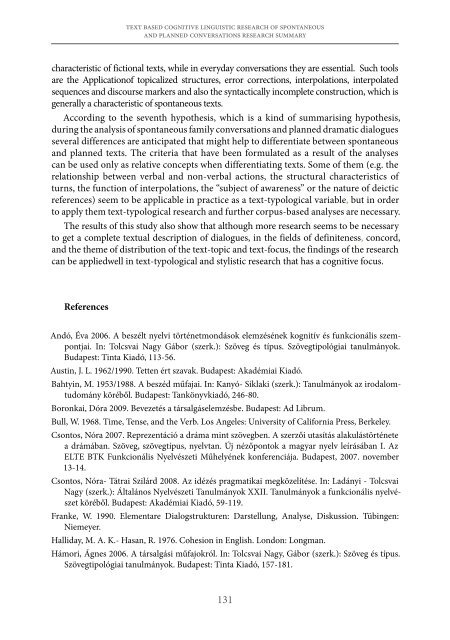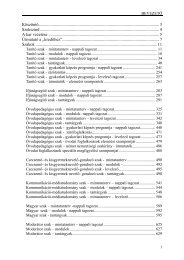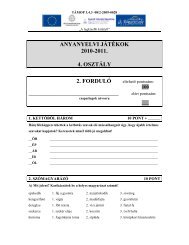ACTA SZEKSZARDIENSIUM - Pécsi Tudományegyetem Illyés Gyula ...
ACTA SZEKSZARDIENSIUM - Pécsi Tudományegyetem Illyés Gyula ...
ACTA SZEKSZARDIENSIUM - Pécsi Tudományegyetem Illyés Gyula ...
You also want an ePaper? Increase the reach of your titles
YUMPU automatically turns print PDFs into web optimized ePapers that Google loves.
text based cognitive linguistic research of spontaneous<br />
and planned conversations research summary<br />
characteristic of fictional texts, while in everyday conversations they are essential. Such tools<br />
are the Applicationof topicalized structures, error corrections, interpolations, interpolated<br />
sequences and discourse markers and also the syntactically incomplete construction, which is<br />
generally a characteristic of spontaneous texts.<br />
According to the seventh hypothesis, which is a kind of summarising hypothesis,<br />
during the analysis of spontaneous family conversations and planned dramatic dialogues<br />
several differences are anticipated that might help to differentiate between spontaneous<br />
and planned texts. The criteria that have been formulated as a result of the analyses<br />
can be used only as relative concepts when differentiating texts. Some of them (e.g. the<br />
relationship between verbal and non-verbal actions, the structural characteristics of<br />
turns, the function of interpolations, the “subject of awareness” or the nature of deictic<br />
references) seem to be applicable in practice as a text-typological variable, but in order<br />
to apply them text-typological research and further corpus-based analyses are necessary.<br />
The results of this study also show that although more research seems to be necessary<br />
to get a complete textual description of dialogues, in the fields of definiteness, concord,<br />
and the theme of distribution of the text-topic and text-focus, the findings of the research<br />
can be appliedwell in text-typological and stylistic research that has a cognitive focus.<br />
References<br />
Andó, Éva 2006. A beszélt nyelvi történetmondások elemzésének kognitív és funkcionális szempontjai.<br />
In: Tolcsvai Nagy Gábor (szerk.): Szöveg és típus. Szövegtipológiai tanulmányok.<br />
Budapest: Tinta Kiadó, 113-56.<br />
Austin, J. L. 1962/1990. Tetten ért szavak. Budapest: Akadémiai Kiadó.<br />
Bahtyin, M. 1953/1988. A beszéd műfajai. In: Kanyó- Síklaki (szerk.): Tanulmányok az irodalomtudomány<br />
köréből. Budapest: Tankönyvkiadó, 246-80.<br />
Boronkai, Dóra 2009. Bevezetés a társalgáselemzésbe. Budapest: Ad Librum.<br />
Bull, W. 1968. Time, Tense, and the Verb. Los Angeles: University of California Press, Berkeley.<br />
Csontos, Nóra 2007. Reprezentáció a dráma mint szövegben. A szerzői utasítás alakulástörténete<br />
a drámában. Szöveg, szövegtípus, nyelvtan. Új nézőpontok a magyar nyelv leírásában I. Az<br />
ELTE BTK Funkcionális Nyelvészeti Műhelyének konferenciája. Budapest, 2007. november<br />
13-14.<br />
Csontos, Nóra- Tátrai Szilárd 2008. Az idézés pragmatikai megközelítése. In: Ladányi - Tolcsvai<br />
Nagy (szerk.): Általános Nyelvészeti Tanulmányok XXII. Tanulmányok a funkcionális nyelvészet<br />
köréből. Budapest: Akadémiai Kiadó, 59-119.<br />
Franke, W. 1990. Elementare Dialogstrukturen: Darstellung, Analyse, Diskussion. Tübingen:<br />
Niemeyer.<br />
Halliday, M. A. K.- Hasan, R. 1976. Cohesion in English. London: Longman.<br />
Hámori, Ágnes 2006. A társalgási műfajokról. In: Tolcsvai Nagy, Gábor (szerk.): Szöveg és típus.<br />
Szövegtipológiai tanulmányok. Budapest: Tinta Kiadó, 157-181.<br />
131




